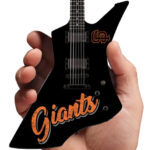For musicians and audio engineers, an audio interface is the crucial bridge connecting instruments and microphones to your computer for recording and production. Essentially, an audio interface allows audio signals to enter and exit your digital audio workstation (DAW). However, with a vast array of options available, selecting the right audio interface can feel overwhelming. Understanding your specific needs and the key features of an audio interface is essential. At Guitar Center, we offer a wide selection of audio interfaces to suit every recording scenario, and our experts are on hand to help you make the perfect choice.
Understanding the Basics: What is an Audio Interface?
At its core, an audio interface is a device that converts analog audio signals into a digital format your computer can understand, and vice versa. This conversion is handled by AD/DA (Analog-to-Digital/Digital-to-Analog) converters. A basic interface performs this fundamental conversion, but higher quality interfaces incorporate “jitter correction” to minimize timing inconsistencies and ensure a cleaner, more accurate audio signal.
However, most modern audio interfaces offer much more than just basic conversion. They often include:
- Mic Preamps: To amplify microphone signals to a usable level for recording.
- Multiple I/O Connections: Offering a variety of inputs and outputs, including balanced, unbalanced, and digital connections, to accommodate different instruments, microphones, and monitoring setups.
- Internal DSP (Digital Signal Processing): Some interfaces include built-in DSP for real-time effects like reverb and EQ, and for creating monitor mixes directly within the interface, reducing latency and CPU load on your computer.
- Standalone Mixer Functionality: Certain interfaces can even operate as simple mixers without being connected to a computer, useful for basic live sound applications.
The Importance of Components: Op-amps and Audio Quality
The quality of components within an audio interface significantly impacts its overall audio performance. Op-amps (operational amplifiers) are particularly crucial. Higher-quality interfaces utilize superior op-amps that minimize noise and distortion, resulting in cleaner and more transparent recordings. Some high-end interfaces even employ discrete components instead of integrated chips for even greater sonic purity. When considering audio quality, paying attention to the specifications and component quality is paramount.
Input and Output (I/O) Connections: Tailoring to Your Needs
The number of inputs and outputs (I/O) on an audio interface is a critical factor determined by your recording requirements.
-
Basic 2-in/2-out interfaces: These are ideal for solo musicians, singer-songwriters, or podcasters who typically record vocals and a single instrument simultaneously, or for stereo recording with a pair of microphones.
-
Expandable interfaces: As your needs grow, interfaces with more inputs and outputs become necessary. Interfaces with 18 inputs and 22 outputs are common and suitable for recording small bands, drum kits, or more complex setups.
-
Professional-grade interfaces: For large-scale recording projects, studios, or orchestral recordings, even larger interfaces are available, and systems like Pro Tools HD can handle extremely high I/O counts.
Consider your current and future recording aspirations when choosing the number of I/O connections.
Connectivity: USB, FireWire, Thunderbolt, and More
The connection type between your audio interface and computer is another important consideration, with several options available:
-
USB: USB interfaces are popular for their versatility and compatibility. USB interfaces, especially USB 2.0 and USB 3.0, are widely used in mobile interfaces and offer sufficient bandwidth for many recording applications. However, for very high channel counts and low latency demands, other options might be preferable.
-
FireWire (IEEE 1394): FireWire is known for its robust and fast data transfer capabilities. While less common on newer computers, FireWire interfaces are still a viable option, often requiring an external power supply.
-
PCI/PCIe: PCI and PCIe cards offer the highest bandwidth and lowest latency, making them ideal for professional studio environments demanding maximum performance. However, these are internal cards limited to desktop computers.
-
Thunderbolt: Apple’s Thunderbolt connection provides exceptional speed and bandwidth, making it a top choice for high-performance audio interfaces, especially for users of newer Macintosh computers.
Each connectivity type has its strengths and weaknesses depending on your specific needs and computer setup.
Explore Top Audio Interface Brands at Guitar Center
Guitar Center carries a wide range of reputable audio interface brands, including:
- Akai
- Apogee
- Avid
- Focusrite
- M-Audio
- MOTU
- Presonus
- Roland
- Tascam
- Yamaha
These brands are known for producing quality audio interfaces for various budgets and applications. Exploring these brands at Guitar Center will help you find an interface that aligns with your specific requirements and sonic preferences.
Professional Audio Solutions at GC Pro
For demanding professional environments like recording studios and post-production facilities, Guitar Center’s GC Pro division offers specialized, high-end solutions. These include systems like:
- Avid HDX Systems: Industry-standard professional audio production systems known for their power and flexibility.
- Focusrite RedNet Series: Networked audio interfaces utilizing Dante protocol for complex audio routing and distribution in professional settings.
GC Pro experts provide hands-on sales and support for these advanced audio solutions.
Conclusion: Finding Your Ideal Interface at Guitar Center
Choosing the “best” audio interface ultimately depends on your individual needs, recording style, and budget. Factors like audio quality, I/O count, connectivity, and desired features all play a crucial role. The most effective approach is to consider your current and future recording projects and select an interface that adequately meets those demands.
To find the perfect audio interface, we encourage you to visit your local Guitar Center and speak with our Pro Audio specialists. They possess the expertise to guide you through the selection process and help you discover the ideal audio interface to elevate your recordings and musical creations.

